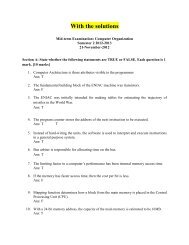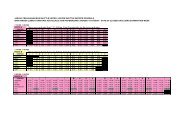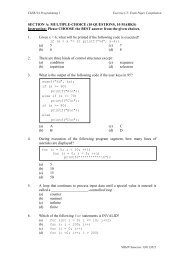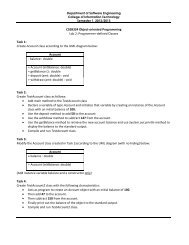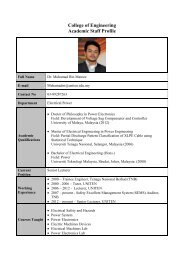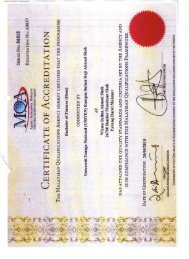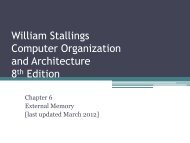Chapter 1.pdf - MetaLab
Chapter 1.pdf - MetaLab
Chapter 1.pdf - MetaLab
You also want an ePaper? Increase the reach of your titles
YUMPU automatically turns print PDFs into web optimized ePapers that Google loves.
Living in a NetworkCentric WorldNetwork Fundamentals – <strong>Chapter</strong> 1ITE PC v4.0<strong>Chapter</strong> 1 © 2007 Cisco Systems, Inc. All rights reserved. Cisco Public1
Objectives• Describe how networks impact our daily lives.• Describe the role of data networking in the humannetwork.• Identify the key components of any data network.• Identify the opportunities and challenges posed byconverged networks.• Describe the characteristics of network architectures:fault tolerance, scalability, quality of service andsecurity.ITE PC v4.0<strong>Chapter</strong> 1 © 2007 Cisco Systems, Inc. All rights reserved. Cisco Public2
Outline• The network as a platform•Communicating over networks•Elements of a network•Converged networks• The architecture of the Internet•The network architecture•Fault-tolerant network architecture•Scalable network architecture•Providing Quality of Service•Providing network securityITE PC v4.0<strong>Chapter</strong> 1 © 2007 Cisco Systems, Inc. All rights reserved. Cisco Public3
How Networks Impact Daily Life• People need to interact with each others for dailyneeds.• With the existence of the Internet, people can nowinteract in ways that are not possible before.• The Internet allows people to share and distribute alltypes of information.Documents, pictures, sound, video.Can be done regardless of location.ITE PC v4.0<strong>Chapter</strong> 1 © 2007 Cisco Systems, Inc. All rights reserved. Cisco Public4
Network Supporting the Way We Live• Early communication relies on face-to-faceconversation.• As our society advances, other means ofcommunication emerged.Mail (written message)Telephone (voice)Television broadcast (one-way video communication).• With the use of the Internet, all the different typesof communication are converging into Web-basedcommunication.ITE PC v4.0<strong>Chapter</strong> 1 © 2007 Cisco Systems, Inc. All rights reserved. Cisco Public5
Network Supporting the Way We Live• Early data networks were limited to exchangingcharacter-based information between connectedcomputer systems.• Current networks have evolved in mainly two ways:•They can carry various types of information: text, graphics,voice, video streams.•They can support different types of devices: computers,PDAs, mobile phones, webcams, refrigerator, microwave(pretty anything you can think of…).• National borders, geographic distances and physicallimitations become less relevant.ITE PC v4.0<strong>Chapter</strong> 1 © 2007 Cisco Systems, Inc. All rights reserved. Cisco Public6
Network Supporting the Way We Live• The Internet nowadays is used in various ways:Receive and send emailObtain information and adviceOnline shopping and selling / auctionElectronic banking• Examples of today’s popular communication tools:Instant messagingBlogsPodcastingWikisITE PC v4.0<strong>Chapter</strong> 1 © 2007 Cisco Systems, Inc. All rights reserved. Cisco Public7
• Instant messagingReal time communication between 2 or more people based ontext• Weblogs (Blogs)Web pages created by anindividual• PodcastingWebsite that contains audiofiles available for downloadingITE PC v4.0<strong>Chapter</strong> 1 © 2007 Cisco Systems, Inc. All rights reserved. Cisco Public8
Network Supporting the Way We Learn• The Internet can enhance learning and makes iteasier in several ways:Distribution of learning contentsAvailability of various resourcesEnable learning to be done from any location• Courses delivered using Internet resources arecommonly called online learning or e-learning.• Benefits of e-learning:Easy update of learning materialsAvailability to a wide audienceConsistent quality of instructionCost reductionITE PC v4.0<strong>Chapter</strong> 1 © 2007 Cisco Systems, Inc. All rights reserved. Cisco Public9
Network Supporting the Way We Work• The use of network can enhance communicationbetween employees in an organization and alsowith external clients.• Most companies have an intranet.A private network belonging to the company.Allows communication between employees and alsobetween branches.• Some companies also have an extranet.A network (or network resources) to provide suppliers,vendors, customers, limited access to corporate data.Example of common data to be shared: order status,inventory, parts lists.ITE PC v4.0<strong>Chapter</strong> 1 © 2007 Cisco Systems, Inc. All rights reserved. Cisco Public10
Network Supporting the Way We Work• The use of technology like VPN (virtual privatenetwork) allows employees to access company’sintranet remotely.Work can be done even though the employee isoutstation or at home.• In certain countries, there is a rising trend on theconcept of “working from home”.No longer need to go to the office every day.Communications with other employees or clients can bedone online.Can work and take care of family at the same time.ITE PC v4.0<strong>Chapter</strong> 1 © 2007 Cisco Systems, Inc. All rights reserved. Cisco Public11
Network Supporting the Way We Play• Entertainment is getting much more fun these days.Chatting and instant messagingOnline interest groupsWeb bloggingVideo and audio streamingOnline games• What makes these entertainments really fun is theability to interact with other people.ITE PC v4.0<strong>Chapter</strong> 1 © 2007 Cisco Systems, Inc. All rights reserved. Cisco Public12
What is Communication?• Communication can be in many forms and occursin different environments.• Allows two or more entities to send information toeach other.• For communication to be successful, it must begoverned by a protocol.An agreement or rules that must be followed in order forthe message to be successfully delivered and understood.Used in human communication and also in computercommunication.ITE PC v4.0<strong>Chapter</strong> 1 © 2007 Cisco Systems, Inc. All rights reserved. Cisco Public13
What is Communication?• Among the elements of the protocol that governsuccessful human conversation are:An identified sender and receiverAgreed upon method of communicating: face-to-face,telephone, letterCommon language and grammarSpeed and timing of deliveryConfirmation and acknowledgement requirements.• Protocols used in computer communication sharesmany similar concepts used in the protocol forhuman communication.ITE PC v4.0<strong>Chapter</strong> 1 © 2007 Cisco Systems, Inc. All rights reserved. Cisco Public14
Quality of Communication• Communication between individuals is determined tobe successful when:(Meaning of the message understood by the recipient) ==(meaning intended by the sender)• For data network, the same basic criteria is used tojudge the success of communication.• There are various internal and external factors that mayaffect the communication.ITE PC v4.0<strong>Chapter</strong> 1 © 2007 Cisco Systems, Inc. All rights reserved. Cisco Public15
Communicating over Networks• All networks have four basicelements in common:–Rules/Protocol•Rules that govern howmessages are sent, directed,received and interpreted.–Medium•This is how the devices areconnected together•Can be wired or wireless–Messages•Information that travels overthe medium–DevicesDevices on the network thatexchange messages tocommunicate with one another.ITE PC v4.0<strong>Chapter</strong> 1 © 2007 Cisco Systems, Inc. All rights reserved. Cisco Public16
Converged Networks• Traditionally, telephone, radio, television andcomputer data networks are four separatenetworks.Each has its own versions of the four basic elements.• Technology advances has allowed the fournetworks to be combined together.This combined network is referred to as a convergednetwork.Voice, video and data can be carried over the samenetwork.Eliminate the needs to create and maintain separatenetworks.ITE PC v4.0<strong>Chapter</strong> 1 © 2007 Cisco Systems, Inc. All rights reserved. Cisco Public17
Converged Networks• A type of network that can carry voice, video & dataover the same networkITE PC v4.0<strong>Chapter</strong> 1 © 2007 Cisco Systems, Inc. All rights reserved. Cisco Public18
Network Architecture• Network architecture refers to:Technologies that support the network infrastructure.Programmed services and protocols that move messagesacross that infrastructure.• There are four basic characteristics that areaddressed by network architecture design tomeet user expectations:Fault toleranceScalabilityQualify of Service (QoS)SecurityITE PC v4.0<strong>Chapter</strong> 1 © 2007 Cisco Systems, Inc. All rights reserved. Cisco Public19
A Fault-tolerant Network Architecture• Fault-tolerance refers to the ability of the networkto:Limit the impact of hardware and software failuresRecover quickly when failure occurs• Before computer network is invented, thetelephone network is already in existence.• Telephone network is a circuit-switched,connection-oriented network.A circuit is established before data transfer. Thisrepresents the path to be taken.Resources are dedicated for each circuit – fixed data rate.ITE PC v4.0<strong>Chapter</strong> 1 © 2007 Cisco Systems, Inc. All rights reserved. Cisco Public20
A Fault-tolerant Network ArchitectureAny failure in the path may cause the connection to beterminated.Has limited number of circuits. During peak periods, some callsmay be denied.Circuit stays active even if no one is speaking – inefficient useof resources.• Circuit-switching network is not very fault-tolerant andcan be costly (due to inefficient use of networkresources).Not very suitable for data networks.ITE PC v4.0<strong>Chapter</strong> 1 © 2007 Cisco Systems, Inc. All rights reserved. Cisco Public21
A Fault-tolerant Network Architecture• Fault-tolerance can be improved by using a packetswitched,connectionless network.A single message is broken into multiple message blockscalled packets.Packet contains address information of the sender andreceiver.No path needs to be established before data transmission(connectionless).Different packets belonging to the same message can besent through the network along various paths.The original message will be reassembled once all thepackets arrive at the receiver.• The Internet is a packet-switching network.ITE PC v4.0<strong>Chapter</strong> 1 © 2007 Cisco Systems, Inc. All rights reserved. Cisco Public22
Network Architecture CharacteristicsITE PC v4.0<strong>Chapter</strong> 1 © 2007 Cisco Systems, Inc. All rights reserved. Cisco Public23
A Scalable Network Architecture• Scalability refers to the ability of the network to expandquickly to support new users and applications withoutimpacting the performance of the service beingdelivered to existing users.• The Internet architecture is scalable due to thefollowing characteristics:It has a hierarchical layered structure for addressing, namingand connectivity service.It uses common standards and protocols.ITE PC v4.0<strong>Chapter</strong> 1 © 2007 Cisco Systems, Inc. All rights reserved. Cisco Public24
Network Architecture CharacteristicsITE PC v4.0<strong>Chapter</strong> 1 © 2007 Cisco Systems, Inc. All rights reserved. Cisco Public25
A Scalable Network Architecture• There is no single organizations that regulates theInternet.• Different software and hardware products are able towork with each others by following accepted standardsand protocols.This allows many new different products and services to bedeployed on the Internet.These new products and services make the Internet moreuseful and therefore attract more users.ITE PC v4.0<strong>Chapter</strong> 1 © 2007 Cisco Systems, Inc. All rights reserved. Cisco Public26
Providing Quality of Service (QoS)• QoS indicates the performance level of theservices offered through the network.• Traditional computer applications do not muchrequirement in terms of QoS.• However, multimedia applications such as audioand video streaming requires consistent quality anduninterrupted delivery.• The problem is that the Internet architecture doesnot have any mechanism to provide QoS.Packets may or may not arrive.If arrive it may not be on time or may not be in order.ITE PC v4.0<strong>Chapter</strong> 1 © 2007 Cisco Systems, Inc. All rights reserved. Cisco Public27
Providing Quality of Service (QoS)• The key concept behind providing QoS is tomanage the utilization of network resources.• Applications that have certain quality requirementsshould be given more priority to use networkresources.In the situation where network resources are notsufficient, low-priority packets can be delayed or dropped.• There are various techniques to implement QoS inthe Internet. One way is to use priority queue at thenetwork routers.ITE PC v4.0<strong>Chapter</strong> 1 © 2007 Cisco Systems, Inc. All rights reserved. Cisco Public28
Network Architecture CharacteristicsITE PC v4.0<strong>Chapter</strong> 1 © 2007 Cisco Systems, Inc. All rights reserved. Cisco Public29
Network Architecture CharacteristicsITE PC v4.0<strong>Chapter</strong> 1 © 2007 Cisco Systems, Inc. All rights reserved. Cisco Public30
Network Architecture CharacteristicsITE PC v4.0<strong>Chapter</strong> 1 © 2007 Cisco Systems, Inc. All rights reserved. Cisco Public31
Providing Network Security• The Internet nowadays are used for exchangingconfidential and business critical information.Unauthorized use of communication data might haveserious consequences.• Two types of network security concerns that mustbe addressed.Network infrastructure security – physically securing thenetwork devices and preventing unauthorized access.Content security – protecting the information contained inthe packets while being transmitted over the network andwhile being stored on network-attached devices.ITE PC v4.0<strong>Chapter</strong> 1 © 2007 Cisco Systems, Inc. All rights reserved. Cisco Public32
Providing Network Security• Security measures taken in a network should:Prevent unauthorized disclosure or theft of information –ensuring confidentialityPrevent unauthorized modification of information – ensuringintegrityPrevent denial-of-service (DoS) – ensuring availability.ITE PC v4.0<strong>Chapter</strong> 1 © 2007 Cisco Systems, Inc. All rights reserved. Cisco Public33
Providing Network Security• Basic measures to secure data networks include:Ensure integrity through the use of user authentication and dataencryption.Maintain communication integrity through the use of digitalsignatures.Ensure availability through the use of:FirewallsRedundant network architectureHardware without a single point of failureITE PC v4.0<strong>Chapter</strong> 1 © 2007 Cisco Systems, Inc. All rights reserved. Cisco Public34
Trends in Networking• Three major trends that are contributing to the futureshape of complex information networks:Increasing number of mobile usersProliferation of network capable devicesExpanding range of services• As network increase in sophistication, the demand forpeople with networking skills will continue to grow.ITE PC v4.0<strong>Chapter</strong> 1 © 2007 Cisco Systems, Inc. All rights reserved. Cisco Public35
ITE PC v4.0<strong>Chapter</strong> 1 © 2007 Cisco Systems, Inc. All rights reserved. Cisco Public36



